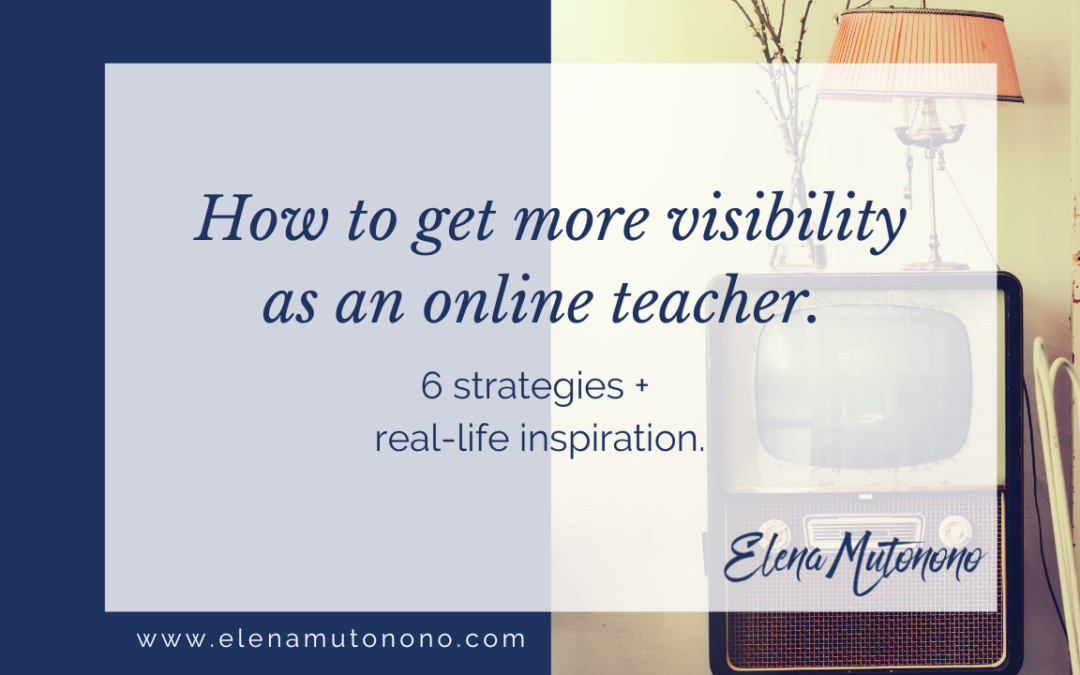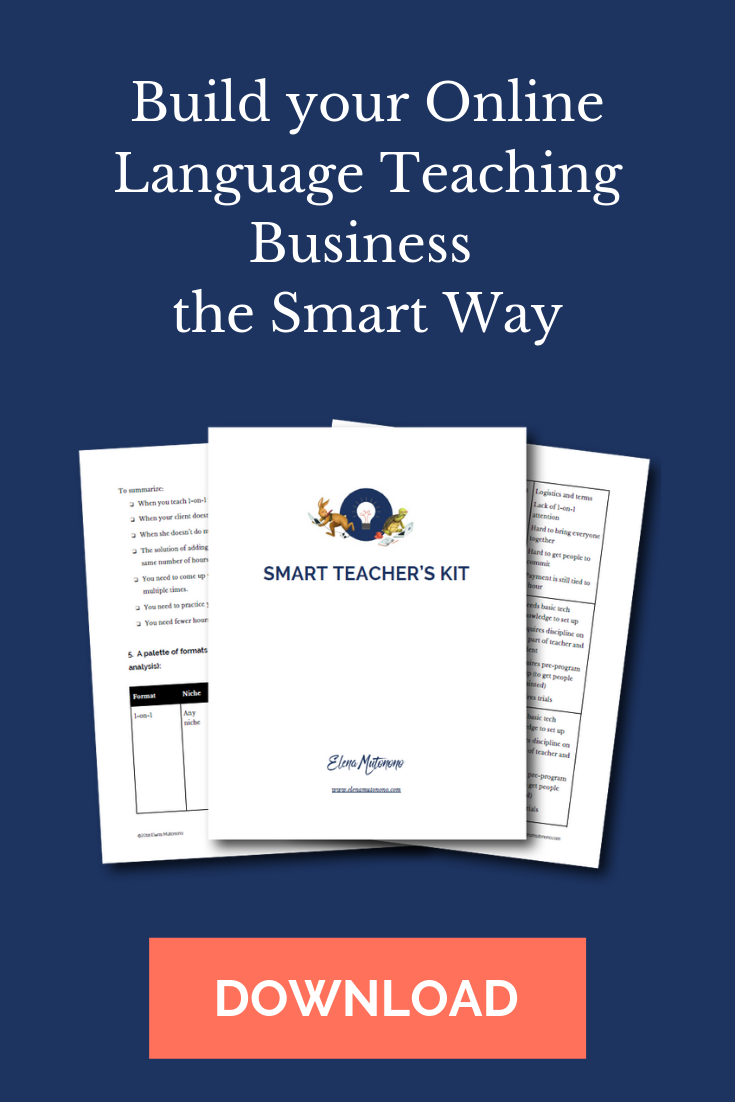If you’ve been teaching for a platform or subcontracting as an online teacher, going on your own might be a challenging transition. There’s nobody doing the marketing for you, nobody “bumping” your profile to the top of your search, so you lack the visibility to bring in your own clients, sell courses or products and grow your community.
Social media gets more crowded, and creating your own content doesn’t convince your audience to buy from you there and then, so how do you bring your work in front of a larger audience?
In this post I’m going to share with you a few strategies that will help you boost your visibility as an online teacher without heavy investment in advertising.
I must give a quick disclaimer that gaining visibility is something we do on a regular basis, even when we have established an audience. It’s what feeds the growth of our business and gives us new ideas on what to create and how to serve the people who like our work.
#1: Figure out how your work is different.
Most of the time we struggle with getting visibility because we think of ourselves as bland and boring. “Oh, I just give lessons online.” “Oh, I just help people pass their tests. Everyone can do it.” I get it. The online language teaching industry is huge, and it’s not easy to stand out.
Understanding your so-called unique selling point, or how you’re different, takes work. You step outside the boundaries of a safe online platform (that decides for you how much you should charge and what you should teach, and how your profile should look like) and boldly talk about yourself.
It’s not easy and it’s often frustrating. And it’s evolving together with you and your business. But it’s essential if you want to gain more visibility. You can’t approach other people and say “Can I get on your podcast? I need more clients.” That’s pretty boring and no audience will be enlightened listening to a dude who just wants to make a buck.
If defining your teaching niche is a challenge, check out my Dare to Be Different workshop. It’s just 1 hour, and it’s got a workbook that you can use and reuse in the future. Once you’re able to distinguish your work from others, getting visibility becomes less challenging.
#2: Create your visibility strategy.
I’m sure you follow a number of teachers online. It helps you see what others are doing, get ideas for your own work (please, steal like an artist, LOL) and maybe sulk in negative comparison once in a while (don’t stay there too long). You can also use some information about people in your industry to build your visibility strategy.
Here’s how:
- Google the name of one of the “influencers” in your industry. Who is the coolest Italian teacher out there? A German teacher? A Japanese teacher? A Shona teacher?
- If you don’t know (or don’t follow) any cool teachers in your industry, google “interactive Italian lessons” or “how to improve German writing,” etc. Be specific.
- See where your favorite “influencer” shows up in search. Take note of where they wrote guest posts or which podcasts they went on.
- Repeat the same strategy with a few other people. Notice patterns. Pay attention to the podcasts/blogs where these people show up.
- Think of your niche and how you can contribute to a particular blog or podcast or youtube channel? Think of specific topics and then pitch them to the creator.
#3: Write a pitch email to the creator.
I know you might be wondering, why would a “big creator” be interested in working with someone as small as you? Quick answer: when you have a bigger platform, content creation becomes more critical than when your blog is tiny.
Now that your website is actually making money, attracting clients and bringing curious learners, you want to keep it going. The way to do it is by creating fresh content on the topic(s) within your niche. So creators with bigger websites need all the help they can get to find new writers and new guests for their podcasts.
You may not get published tomorrow, but your topic may be considered for publication. That’s how I wrote for LearnOutLive, Fluentin3Months and was featured on the Langpreneur and Language Hacking podcast, in our industry only.
Don’t forget to keep track of all the people you reach out to so you can follow up within a week or so. Inboxes get busy, and emails get lost. Stay positive, polite and persistent.
#4: Consider getting visibility through creators from overlapping niches.
How does your niche overlap with others?
Can you connect with travel bloggers?
Can you write for mental health publications about the benefits of language learning?
Can you share your immigration/travel/expat story?
Can you talk about how you use tech while teaching online?
Can you write about your experiences teaching online as a mother?
If so, pick one topic and go back to research. Where do people talk about these topics? What are some publications that might be interested in hearing your unique story?
#5: Consider shoutouts.
If you’re not feeling confident enough to write to people and ask if they would consider inviting you to their podcast yet, start by being the best fan ever. If you find something that’s of interest to you and might be helpful to your clients, share the links on social media and in your newsletter.
Then write to the creator and let them know that you shared their work. It may sound like a trivial thing, but it means a lot to the person on the other side of the screen. When you build such a connection, it will be easier to ask for a favor later, if the opportunity arises.
#6: Build connections with peers.
I used to think – why bother? Why would anyone want to help me out when they need help themselves? But that was my scarcity speaking, something that I’ve been actively working on for the past several years. Scarcity speaks: don’t share, don’t collaborate – people might steal your work and make a living with it.
On the flipside, abundance says: rising tide lifts all boats. It says: when you help others you also help yourself. It says: working together helps you understand your differences better. There’s definitely a lot of joy and fulfillment in collective creativity. “Just do it” Nike slogan wouldn’t have come about without collective effort.
A great number of teachers in our Smart Teacher’s Library would not have gotten their incredible programs off the ground without the help and support of others. It’s not that you can’t do it on your own. You can. But why should you when working together creates more support and joy?
A tiny motivation (aka a kick in the butt).
I know that visibility is something we online teachers need to do all the time. And because it’s something we feel like we need to do or should do, it becomes a huge chore that never gets done. Or we get started and deflate quickly because we don’t hear back from people we reach out to.
When I feel like sulking because none of my efforts seem to pay off I’m reminded of Alexandra Franzen’s quote from her book You’re Going to Survive, “Don’t be mad about the results you don’t get from the work you don’t do.”
I chuckle and then I keep making my turtle steps forward. I’ve reframed the need for visibility into a way to reach more people. If my message is important, then visibility is no longer a chore. It’s the work I do to help more people.
As years go by I look back and realize that I have been able to connect with so many people (check out my OnlineBound Podcast!) just because I wrote that one email and said to myself, “Well, what’s the worst thing that can happen?”



 Welcome to my nook where *Big Magic* happens. My name is Elena Mutonono, I help small business owners package their services as digital products and sell them online. I want you to work smarter, not harder. Increase your impact beyond your current face-to-face clients. Grow your business as you reach more people all over the world.
Welcome to my nook where *Big Magic* happens. My name is Elena Mutonono, I help small business owners package their services as digital products and sell them online. I want you to work smarter, not harder. Increase your impact beyond your current face-to-face clients. Grow your business as you reach more people all over the world.








Amazing post, thank you so much!
You’re welcome, Sziszi! Glad you found it helpful!
Hi Elena,
A very useful blog. It has given me lots of ideas to write about and make myself visible.
You have successfully pumped up some energy into me.
Thank you.
Yay, Hema! Way to go. I’m glad you now have a plan of action 😉
Hi Elena,
It is so good to read you and know that even years later, your ideas are still relevant and useful. And that social media doesn’t have to be the norm.
Reading it every now and then always gives me new ideas. Thanks